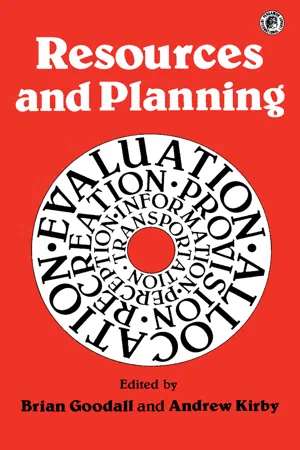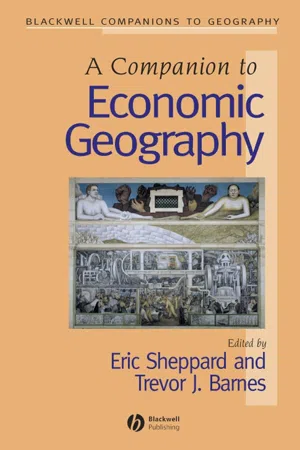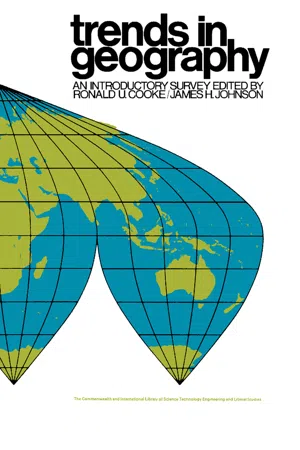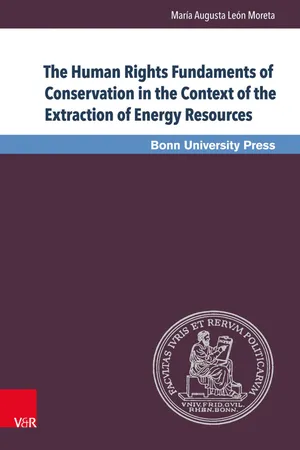Geography
Exploitation of Natural Resources
The exploitation of natural resources refers to the utilization of Earth's resources such as water, minerals, forests, and fossil fuels for economic gain. This often involves extraction, processing, and consumption of these resources, which can lead to environmental degradation, habitat destruction, and depletion of finite resources. Sustainable management and conservation efforts are essential to mitigate the negative impacts of resource exploitation.
Written by Perlego with AI-assistance
Related key terms
1 of 5
4 Key excerpts on "Exploitation of Natural Resources"
- eBook - PDF
Resources and Planning
Pergamon Oxford Geographies
- Brian Goodall, Andrew Kirby, W. B. Fisher, Brian Goodall, Andrew Kirby, W. B. Fisher(Authors)
- 2013(Publication Date)
- Pergamon(Publisher)
Section III INVESTIGATING THE RESOURCE BASE 156 Resources and Planning Introduction Planning and geography are both concerned with the earth as the environment of man: an environment that influences how man lives and organises himself, but which is at the same time an environment that man himself has helped to create and to modify. The environment comprises both space and resources, and one of the functions of planning and geography is to seek a means of improving the ways in which they are used. But man is not only a resource -, or material-using animal; he is also waste-generating creature who increasingly seeks to use the ecological system of the earth for non-utilitarian purposes of a recreational or spiritual kind. The availability of resources creates opportunities for or imposes limitations on the fulfillment of these ambitions. Resources, particularly natural resources are, of course, a product of our society (Spoehr, 1956). They are therefore subject to variations in practice between societies, and through time, owing to different cultural practices: cultural appraisal, involving sensory perception of the environment, transforms nature into resources. The ability to realise the potential of these 'perceived' resources is dependent upon man's command of an effective technology. That same technology contributes to our knowledge and assessment of resource availability as, for example, in the expansion of remote sensing techniques exploiting different parts of the electromagnetic spectrum in geomorphology and the use of satellite surveillance in meteorology and climatology. It is vital to understand that the relationship between man and nature/resources is articulated indirectly through economic and social structure. - eBook - PDF
- Eric Sheppard, Trevor J. Barnes, Trevor J. Barnes, Trevor J. Barnes(Authors)
- 2008(Publication Date)
- Wiley-Blackwell(Publisher)
In some circumstances, mineral exploita-tion is being forgone in recognition of the net costs of environmental, cultural, and economic despoliation that results from the natural resource cycle (Barre, 1998). Natural resources are, of course, necessary factors of production and can't be eliminated from use entirely, nor can their contribution to local economies easily be cast aside. Sustainability, however, requires that resource dependency ± the develop-ment of the resource addiction ± be avoided. Such dependency can be avoided through economic diversification that broadens a regional (from local through national scale) economy's base from a narrow focus on resource exploitation to the employment of available resources as inputs to manufacturing and services. The benefits of economic diversification are well known at the national scale, but they exist at regional and local scales as well. By mitigating the boom and bust of the resource cycle, economic diversification can provide a sustainable base of employ-ment and income. By providing economic alternatives, diversification also can enhance environmental sustainability by reducing the exploitation pressure of local resource dependency. Bibliography Annual Statistical Bulletin 1995 1996. Vienna: Secretariat, Organization of the Petroleum Exporting Countries. Auty, R. M. 1995. Industrial policy, sectoral maturation, and postwar economic growth in Brazil: The resource curse thesis. Economic Geography , 71, 257±72. Barbier, E. B. 1989. Economics, Natural Resource Scarcity and Development . London: Earth-scan Publications. Barnes, T. J. 1994. Staples theory. In R. J. Johnston, D. Gregory, and D. Smith (eds), The Dictionary of Human Geography , third edition. Oxford: Blackwell, 589±91. Barre, D. 1998. Cold war. Greenpeace Magazine , 3, 3 (Fall), 12±14. Bhagwati, J. 1958. Immiserising growth: A geometrical note. Review of Economic Studies , 25, 201±5. - eBook - PDF
Trends in Geography
An Introductory Survey
- Ronald U. Cooke, James H. Johnson, Ronald U. Cooke, James H. Johnson(Authors)
- 2013(Publication Date)
- Pergamon(Publisher)
By adding a more articulate spatial component to these studies, geog-raphers will be in a much stronger position not only to clarify their own interpretation of nature's endowments, but also to give a stronger lead in those debates on natural resources which increasingly command public atten-tion. REFERENCES AND FURTHER READING RESOURCE EVALUATION AND THE GEOGRAPHER Especially noteworthy amongst recent major resource appraisals of minerals and energy are: ADELMAN, M . A . (1964) World oil outlook, in Clawson M . (Ed.) Natural Resources and Inter-national Development, Johns Hopkins, Baltimore. BROOKS, D. B. (1966) Low Grade and Non-conventional Sources of Manganese, Johns Hopkins, Baltimore. BRUBAKER, S. (1967) Trends in the World Aluminum Industry, Johns Hopkins, Baltimore. FISHER, J. L . and POTTER, N . (1964) World Prospects for Natural Resources, Johns Hopkins, Baltimore. LANDSBERG, H. H. (1964) Natural Resources for U.S. Growth, Johns Hopkins, Baltimore. LANDSBERG, H. H., FISCHMANN, L. L. and FISHER. J. L. (1963) Resources in America's Future, Patterns of Requirements and Availabilities, 1960-2000, Johns Hopkins, Baltimore. The issues of resource definition are discussed in : NETSCHERT, B. C. and LANDSBERG, H. H. (1961) The Future Supply of Major Metals, Johns Hopkins, Baltimore. SCHURR, S. H. and NETSCHERT, B. C. (1960) Energy in the American Economy, 1850-1975, Johns Hopkins, Baltimore. Geographical contributions to the study of resources include: BEAVER, S. H. (1964) Mineral resources and power, in WATSON, J. W. and SISSONS, J. B. (Eds.) The British Isles, a systematic geography, Nelson, London. HUMPHRYS, G. (1964) The coal industry, in MANNERS, G. (Ed.) South Wales in the Sixties, Pergamon, Oxford. MANNERS, G. (1964) The Geography of Energy, Hutchinson, London. ODELL, P. R . (1963) An Economic Geography of Oil, Bell, London. New Resource Evaluations 163 ODELL, P. R. (1966) A three point approach necessary to exploit sea gas, The Times (21 July). - eBook - PDF
- María Augusta León Moreta(Author)
- 2015(Publication Date)
- V&R Unipress(Publisher)
2. Extraction of Energy Sources The first stage in an energy system is the extraction of energy resources. This activity can exert significant pressure on these sources and on the environment depending on energy demand, mainly driven by population growth, economic development and patterns of consumption. The exploitation of energy resources has been defined as methods of turning energy sources into productive and profitable uses. These methods, however, differ greatly depending on the various types of resources. 250 Natural resources used in the generation of energy range from raw materials (renewable and non-renewable resources and environmental media), flow resources (wind, sun, tidal waves, geothermic) to space. Since the focus of this work is on analysing the link between environment and human rights in the context of the extraction of energy resources and its consequences on the environment and population, it is important to understand the factors and methods bearing on the extraction process. Therefore, the analysis below will address the extraction processes of raw materials and the use of environ- mental media for the generation of non-renewable energy (fossil fuels) and renewable energy (hydroelectric power and biomass) as well as to the con- sequences of this activity on the environment and the population. a. Non-renewable Energy Resources : Basic Components for the Generation of Fossil Fuels According to the European Environmental Agency, fossil fuels are ‘one of the most important and strategic natural resources in modern society’ and con- stitute ‘the primary natural resource for satisfying the growing energy needs of industrialized countries.’ 251 Moreover, fossil fuels are now strategic instruments for ensuring economic growth in emerging countries since they support their industrialization process. In fact, the demand for fossil fuels has considerably increased in emerging countries because of the recent experimented in- dustrialization.
Index pages curate the most relevant extracts from our library of academic textbooks. They’ve been created using an in-house natural language model (NLM), each adding context and meaning to key research topics.



